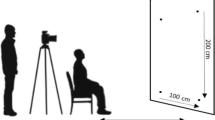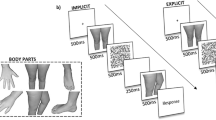Abstract
Three studies were conducted to determine whether action figures contributed to negative body images in the young adult men who handled them. In Study 1 and Study 2, participants were randomly assigned to different conditions to handle action figures with different muscularity levels. The participants were instructed to place the action figures into various positions for a set time limit. Following the action figure manipulation, the participants completed scales to assess aspects of their body images (i.e., self-esteem, body esteem, and body satisfaction). Overall, the results indicate that touching and manipulating the more unrealistically muscular action figures significantly decreased participants' body esteem. In Study 3, we used a more realistic figure whose muscularity was more like an average man's. Following the same procedure as in Study 1 and Study 2, results showed that there was no significant difference between this action figure and the control group on all of the body image scales.
Similar content being viewed by others
References
Agliata, D.,& Tantleff-Dunn, S. (2004). The impact of media exposure on males' body image. Journal of Social and Clinical Psychology, 23, 7–22.
Baranowski, M. J., Jorga, J., Djordjevic, I., Marinkovic, J.,& Hetherington, M. M. (2003). Evaluation of adolescent body satisfaction and associated eating disorder pathology in two communities. European Eating Disorders Review, 11, 478–495.
Blovin, A. G.,& Goldfield, G. S. (1995). Body image and steroid use in male bodybuilders. International Journal of Eating Disorders, 18, 159–165
Bohne, A., Keuthen, N. J., Wilhelm, S., Deckersback, T.,& Jenike, M. A. (2002). Prevalence of symptoms of body dysmorphic disorder and its correlates: A cross-cultural perspective. Psychosomatics, 43, 486–490.
Cash, J. F. (2002). The Situational Inventory of Body Image Dysmorphia: Psychometric evidence and development of a short form. International Journal of Eating Disorders, 32, 362–366.
Cohane, G. H.,& Pope, H. G. (2001). Body image in boys: A review of the literature. International Journal of Eating Disorders, 29, 373–379.
Cooper, P. J., Taylor, M. J., Cooper, Z.,& Fairburn, C. G. (1987). Development and validation of the Body Shape Questionnaire. International Journal of Eating Disorders, 6, 485–494.
Furnham, A., Badmin, N.,& Sneade, I. (2002). Body image dissatisfaction: Gender differences in eating attitudes, self-esteem, and reasons for exercise. Journal of Psychology, 136, 581–596.
Garner, D. M.,& Olmsted, M. P. (1984). Manual for the Eating Disorder Inventory (EDI). Odessa, FL: Psychological Assessment Resources.
Groesz, L. M., Levine, M. P.,& Murnen, S. K. (2002). The effect of experimental presentation of thin media images on body satisfaction: A meta-analytic review. International Journal of Eating Disorders, 31, 1–16.
Hargreaves, D.,& Tiggeman, M. (2002). The effect of television commercials on mood and body dissatisfaction: The role of appearance-schema. Journal of Social and Clinical Psychology, 21, 287–308.
Harrison, K. (2000). The body electric: Thin-ideal media and eating disorders in adolescents. Journal of Communication, 50, 119–143.
Kalodner, C. R. (1997). Media influences on male and female non-eating-disordered college students: A significant issue. Eating Disorders, 5, 47–57.
Kearney-Cooke, A. (2002). Familial influences on body image development. In T. Cash& T. Pruzinsky (Eds.), Body image: A handbook of theory, research, and clinical practice (pp. 99–108), New York: Gilford Press.
Leit, R. A., Gray, J. J.,& Pope, H. G. (2001). Cultural expectations of muscularity in men: The evolution of Playgirl centerfolds. International Journal of Eating Disorders, 29, 90–93.
Leit, R. A., Gray, J. J.,& Pope, H. G. (2002). The media's representation of the ideal male body: A cause for muscle dysmorphia? International Journal of Eating Disorders, 31, 34–338.
Lin, L. F.,& Kulik, J. A. (2002). Social comparison and women's body satisfaction. Basic and Applied Social Psychology, 24, 115–123.
Margo, A. M. (1997). Why Barbie is perceived as beautiful. Perceptual and Motor Skills, 85, 363–374.
Markunas, S. J., Christopher, K. M., Nelson, A. K.,& Miller, B. (2003, May). “Do these pants make my butt look big?” Development of the Male Body Image and Esteem Scale. Poster presented at the meeting of the Midwestern Psychological Association, Chicago, IL.
McCabe, M. P.,& Ricciardelli, L. A. (2003). Sociocultural influences on body image and body changes among adolescent boys and girls. Journal of Social Psychology, 143, 5–26.
McCabe, M. P.,& Ricciardelli, L. A. (2004). Body image dissatisfaction among males across the lifespan: A review of past literature. Journal of Psychosomatic Research, 56, 675–685.
McCabe, M. P., Ricciardelli, L. A.,& Finemore, J. (2002). The role of puberty, media, and popularity with peers on strategies to increase weight, decrease weight, and increase muscle tone among adolescent boys and girls. Journal of Psychosomatic Research, 52, 145–154.
Miller, S. (2002). Body image disturbance in males: An antecedent to eating disorders. Dissertation-Abstracts-International: Section B: The Sciences and Engineering, 62(12-B), 5974.
Murray, S. H., Touyz, S. W.,& Beumont, P. J. (1995). The influence of personal relationships on women's eating behavior and body satisfaction. Eating Disorders, 3, 243–252.
Norton, K. I., Olds, T. S., Olive, S.,& Dank, S. (1996). Ken and Barbie at life size. Sex Roles, 34, 287–294.
Ogden, J.,& Mundray, K. (1996). The effect of media on body satisfaction: The role of gender and size. European Eating Disorders Review, 4, 171–182.
Olivardia, R., Pope, H. G., Borowiecki, J. J.,& Cohane, G. H. (2004). Biceps and body image: The relationship between muscularity and self-esteem, depression, and eating disorder symptoms. Psychology of Men and Masculinity, 5, 112–120.
Palladino, G.,& Pritchard, M. E. (2003). Predictors of body image dissatisfaction in adult men and women. Social Behavior and Personality, 31, 215–222.
Phares, V., Steinberg, A. R.,& Thompson, K. (2004). Gender differences in peer and parental influences: Body image disturbance, self-worth, and psychological functioning in preadolescent children. Journal of Youth and Adolescence, 33, 421–429.
Pope, H. G., Olivardia, R., Gruber, A.,& Borowiecki, J. (1999). Evolving ideals of male body image as seen through action figures. International Journal of Eating Disorders, 26, 65–72.
Ricciardelli, L. A., McCabe, M. P.,& Banfield, S. (2000). Body image and body change methods in adolescent boys: Role of parents, friends, and the media. Journal of Psychosomatic Research, 49, 189–197.
Rosenberg, M. (1965). Society and the adolescent self-image. Princeton, NJ: Princeton University Press.
Sarwer, D. B., Wadden, T. A.,& Foster, G. D. (1998). Assessment of body image dissatisfaction in obese women: Specificity, society, and clinical significance. Journal of Counseling and Clinical Psychology, 66, 651–654.
Silberstein, L. R., Mishkind, M. E., Striegel-Moore, R. H., Timko, C.,& Rodin, J. (1989). Men and their bodies: A comparison of homosexual and heterosexual men. Psychosomatic Medicine, 51, 337–346.
Smith, R. (2000). Linking goal attainment to happiness: A moderator of the media effects on eating disorders? Dissertation-Abstracts-International: Section B: The Sciences and Engineering, 61(4-B), 2223.
Strong, K. O. (2001). Media effects on eating disorders in preadolescent and adolescent females: A program for primary prevention. Dissertation-Abstracts-International: Section B: The Sciences and Engineering, 61(9-B), 5008.
Thompson, J. K.,& Van Den Berg, P. (2002) Measuring body image attitudes among adolescents and adults. In T. Cash& T. Pruzinsky (Eds.), Body image: A handbook of theory, research and clinical practice (pp. 142–152). New York: Gilford Press.
Turkel, A. (1998). All about Barbie: Distortions of a transitional object. The Journal of the American Academy of Psychoanalysis, 26, 165–177.
Author information
Authors and Affiliations
Corresponding author
Rights and permissions
About this article
Cite this article
Barlett, C., Harris, R., Smith, S. et al. Action Figures and Men. Sex Roles 53, 877–885 (2005). https://doi.org/10.1007/s11199-005-8304-4
Issue Date:
DOI: https://doi.org/10.1007/s11199-005-8304-4




